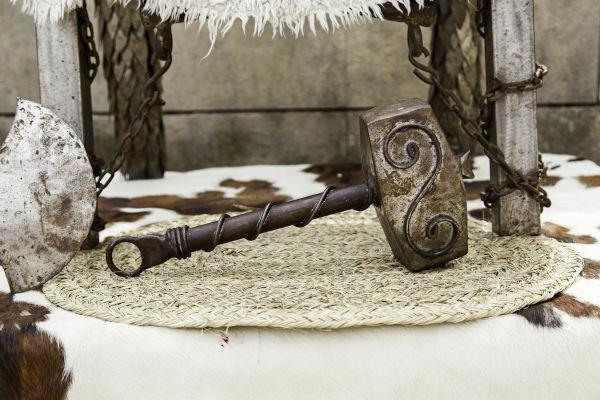Thor was the most popular god of the Norse in the Viking Age, which lasted from 793 to 1066, and was associated with thunder, storms, and agriculture. He was the son of Odin and considered the most powerful god of all, especially when he used his hammer known as Mjölnir. In Norse mythology, Thor would die when he fought Jörmungandr, the giant serpent.
Lookalso: How did the Vikings view war?
Thor summary
Thor was the most popular god among the Norse in the Viking Age.
He was associated with natural phenomena such as thunder, tides and storms.
He had three accessories that enhanced his power: the Mjölnir hammer, the Megingjörd belt, and the Jarnglófar gloves.
He was known as a giant slayer.
In Ragnarök, he would fight Jörmungandr, the giant serpent. He would kill the serpent, but he would fall victim to its venom.
Thor's Story
Thor, Norse god of thunder, sky, storms and agriculture, is one of the gods that are part of the Norse mythology. He is known to be the most popular god of the Norse in the period known as the Viking Age, which spanned from 793 to 1066. This period was the height of the expeditions carried out by the
vikings in northern Europe.The Norse recognized Thor as:
the guardian of Midgard, the land between, the place where humans lived.
the guardian of Asgard, where some of the Norse gods resided.
Thor was the son of Odin and Jörd, and his father was recognized as the wisest god and was called the "father of all". Despite being recognized as a popular Norse god, Thor was a deity derived from the culture germanic, being recognized as Donar among the Germans and held by them as god of thunder. However, gods similar to Thor existed in several cultures in northern Europe at the same time.
Thor was an expert killeringiants, considered the most powerful of all the Norse gods. His strength was manifested by the accessories he wore in battle:
his hammer, called Mjölnir;
the belt that doubled his strength and was called the Megingjörd;
the iron gloves that allowed him to use the hammer. The gloves were called Jarnglófar.
You Norse believed that the sound of thunder was actually the sound of Thor's hammer hitting somewhere. Thor, who owned two goats that pulled his cart when he was traveling, was also seen as O lord of goats, and this is due to the fact that the goats, called Tanngrísnir and Tanngnjóstr, were sacrificed by Thor to provide him with food and for always being resurrected the next day.
Thor was married twice. His first wife was called Járnsaxa, while the second was Sif. Járnsaxa was a giantess, while Sif was identified with the fertility of planting grain. All in all, Thor had four children: Modi, Magni, Lorride and Thrúd.
readalso: Greek gods — the deities that were part of the religion of the ancient Greeks
Thor worship

As mentioned, Thor was the most popular god among the Norse, and performing prayers to him was common. However, it is important to mention that the cult of Thor was carried out mainly by the people of the lower classes, especially among the peasants.
Thor was summoned for various actions in that society. Wedding vows, for example, were performed amid invocations to his name. Furthermore, prayers were said to Thor when people would travel across the sea, when they would go to battle, and for countless other occasions.
Furthermore, the Nordics associated Thor The certain phenomena of nature, like the tides, storms and thunder. Thus, requests for protection on sea voyages made perfect sense in Norse religion, since tides and storms were associated with this god in the culture of this people.
Historians have identified that during a certain period of the Viking Age, It became quite common for the Norse to wear pendants that had Thor's hammer on them. in reference to that god. Scholars have understood this action as a response by the pagan Norse to the growing influence of Christianity in that society, especially from the 11th century onwards.
In addition to the pendants, there were figurines of Thor that were stored in important religious temples of the pagan religion of the Norse, such as the temple of Uppsala.
accessalso: What was religion like in Ancient Egypt?
Thor's Death
As we have seen, the Norse recognized Thor as a giant-slaying god, and there are numerous mentions of this in the myths. Thor had several fights with giants, and his victories highlighted him as the most powerful god of them all. Another great enemy of Thor, besides the giants, was the giant serpent called Jörmungandr.
This serpent was the daughter of Loki, a character present in Norse mythology that generates controversy. As historian Johnni Langer points out|1|, some scholars understand Loki as a god, while others consider him just a giant who resided among the gods. Jörmungandr was the daughter of Loki and the giantess Angrboda.
The Norse believed that Jörmungandr was a bringer of chaos. It was recognized for its gigantic dimensions: the serpent was so big that its greeting encircled the whole world and she could bite her own tail. A Norse myth recounts an episode in which Thor caught the serpent while on a journey.
Norse mythology tells that Thor was destined to fight the serpent giant in the final battle that would determine the end of the Universe and the twilight of the gods. This event is known as Ragnarök, a catastrophic event in which the known Universe would be destroyed and a new one would be reborn with new gods, some of which would survive the catastrophe.
During Ragnarök, Thor would fight the giant serpent and, during the fight, he would kill Jörmungandr, but would die because of the effect ofandyour poison.
Grades
|1| LANGER, Johnni. Thor. In.: LANGER, Johnni (eds.) Dictionary of Norse Mythology: Symbols, Myths and Rites. Hedra: São Paulo, 2015, p. 281.



